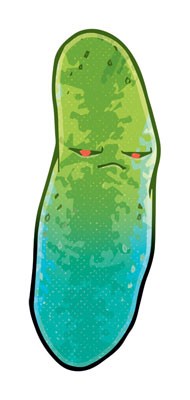By continuing your visit to this site, you accept the use of cookies.
Learn + I agreeCoxiella burnetii

That is the question
Coxiella burnetii is a strictly intracellular1 bacterial species. It is responsible for Q fever, a disease, which owes its name to the difficulty of its diagnosis, Q meaning “Question”.
Distance doesn’t scare it
Sheep and goats are the main natural reservoirs of these bacteria but we can also find them in bovines, cats, dogs, and even ticks.
These bacteria are very resistant and can be transported over several miles by the wind. Therefore, even far away from a sheep or a goat, there is a risk of getting in contact with Coxiella burnetii. Furthermore, a single bacterium is enough to infect a human being.

Directly care of these animals, such as shearing or assistance during birth, increase the risks of being in contact with this bacterial species. Infected animals do not seem sick even though the Coxiella burnetii bacteria are found in great numbers in their placenta, milk, feces, and urine. Most of the time, humans are infected by breathing dust containing dried feces. The consumption of raw sheep or goat milk may also lead to the development of Q fever.


Acute and chronic
There are two distinct forms of the Q fever: acute or chronic.
The first one is usually benign; it may even go practically undetected, with symptoms similar to the flu. In roughly half the cases, patients will display symptoms such as high fever with shivers and headaches. A cough, due to an infection of the lungs, is often present as well. The acute disease may also affect the liver. An antibiotic2 course of two weeks is enough to treat this form of Q fever.
In a minority of people (less than 2%) the chronic form may develop, if they are not cured of the first disease. The chronic form is characterized by a persistent infection, which may for instance affect the heart valves (endocarditis3) or the liver (chronic hepatitis). The chronic infection is harder to cure and can require an antibiotics treatment of more than 18 months.
Therefore, Q fever can sometimes become a severe disease, but thankfully it is quite rare outside of outbreaks. In Switzerland, only 40 to 60 small outbreaks are registered annually (numbers FOPH 2017).
Intracellular1 = Defines a bacterium that needs to be inside a cell to survive and multiply. Some bacteria are strictly intracellular, since they cannot multiply outside of a cell. Then there are facultative intracellular bacteria that can replicate even without a host cell. The strictly intracellular bacteria are difficult to grow in the laboratory and thus often remain undetected with cultivation methods routinely used for diagnostic purposes.
Antibiotic2 = A drug which allows to kill bacteria or at least to stop their growth. Antibiotics act against bacteria, but do not help treat diseases caused by viruses and parasites.
Endocarditis3 = Inflammation of the endocardium. The endocardium is the membrane that lines the heart’s inner wall and covers the cardiac valves. Endocarditis is rare but can be very serious.
